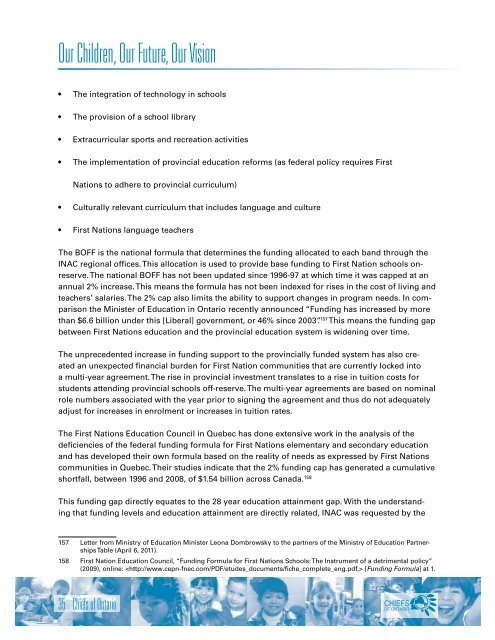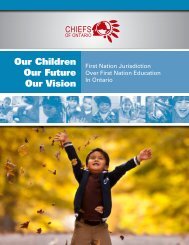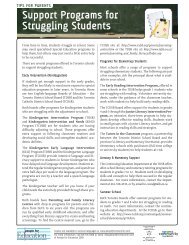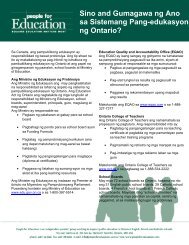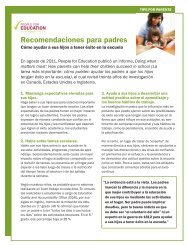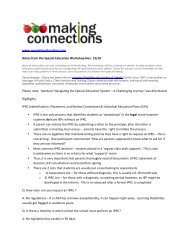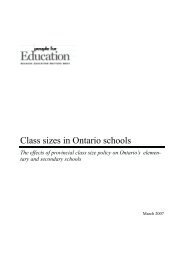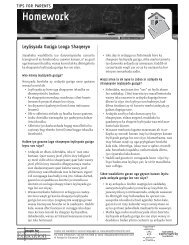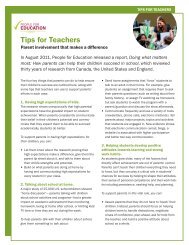Our Children Our Future Our Vision - People for Education
Our Children Our Future Our Vision - People for Education
Our Children Our Future Our Vision - People for Education
Create successful ePaper yourself
Turn your PDF publications into a flip-book with our unique Google optimized e-Paper software.
<strong>Our</strong> <strong>Children</strong>, <strong>Our</strong> <strong>Future</strong>, <strong>Our</strong> <strong>Vision</strong><br />
• The integration of technology in schools<br />
• The provision of a school library<br />
• Extracurricular sports and recreation activities<br />
• The implementation of provincial education re<strong>for</strong>ms (as federal policy requires First<br />
Nations to adhere to provincial curriculum)<br />
• Culturally relevant curriculum that includes language and culture<br />
• First Nations language teachers<br />
The BOFF is the national <strong>for</strong>mula that determines the funding allocated to each band through the<br />
INAC regional offices. This allocation is used to provide base funding to First Nation schools onreserve.<br />
The national BOFF has not been updated since 1996-97 at which time it was capped at an<br />
annual 2% increase. This means the <strong>for</strong>mula has not been indexed <strong>for</strong> rises in the cost of living and<br />
teachers’ salaries. The 2% cap also limits the ability to support changes in program needs. In comparison<br />
the Minister of <strong>Education</strong> in Ontario recently announced “Funding has increased by more<br />
than $6.6 billion under this [Liberal] government, or 46% since 2003”. 157 This means the funding gap<br />
between First Nations education and the provincial education system is widening over time.<br />
The unprecedented increase in funding support to the provincially funded system has also created<br />
an unexpected financial burden <strong>for</strong> First Nation communities that are currently locked into<br />
a multi-year agreement. The rise in provincial investment translates to a rise in tuition costs <strong>for</strong><br />
students attending provincial schools off-reserve. The multi-year agreements are based on nominal<br />
role numbers associated with the year prior to signing the agreement and thus do not adequately<br />
adjust <strong>for</strong> increases in enrolment or increases in tuition rates.<br />
The First Nations <strong>Education</strong> Council in Quebec has done extensive work in the analysis of the<br />
deficiencies of the federal funding <strong>for</strong>mula <strong>for</strong> First Nations elementary and secondary education<br />
and has developed their own <strong>for</strong>mula based on the reality of needs as expressed by First Nations<br />
communities in Quebec. Their studies indicate that the 2% funding cap has generated a cumulative<br />
shortfall, between 1996 and 2008, of $1.54 billion across Canada. 158<br />
This funding gap directly equates to the 28 year education attainment gap. With the understanding<br />
that funding levels and education attainment are directly related, INAC was requested by the<br />
157 Letter from Ministry of <strong>Education</strong> Minister Leona Dombrowsky to the partners of the Ministry of <strong>Education</strong> Partnerships<br />
Table (April 6, 2011).<br />
158 First Nation <strong>Education</strong> Council, “Funding Formula <strong>for</strong> First Nations Schools: The Instrument of a detrimental policy”<br />
(2009), online: [Funding Formula] at 1.<br />
35 Chiefs of Ontario


